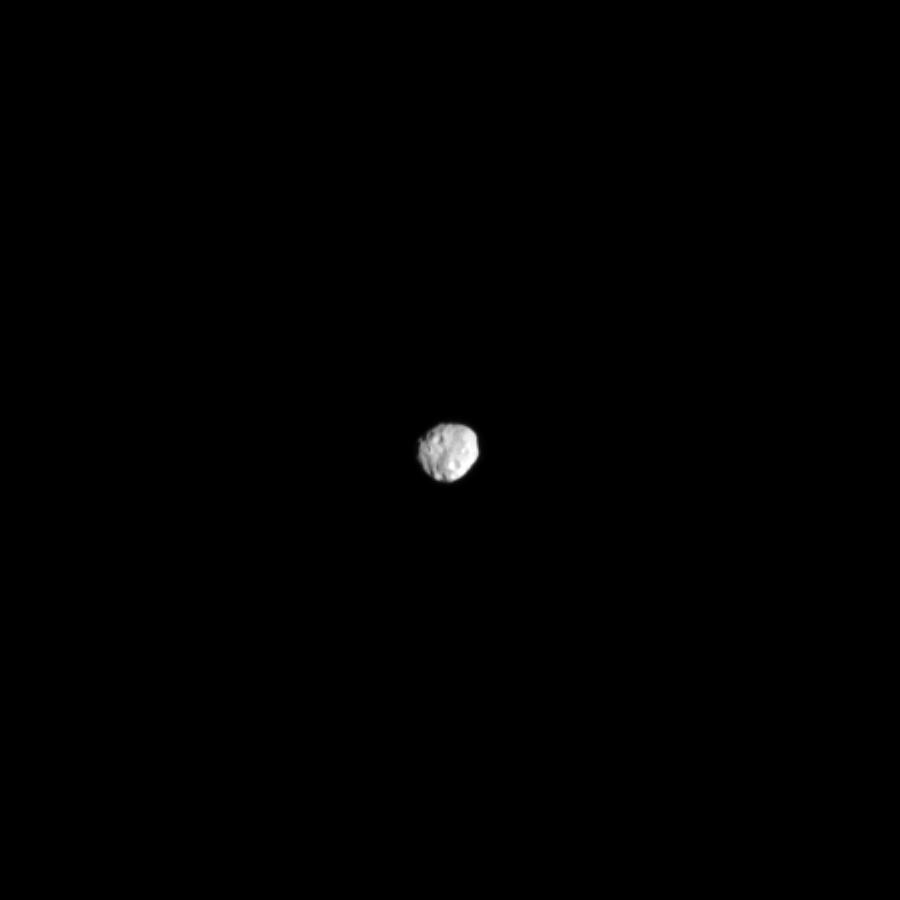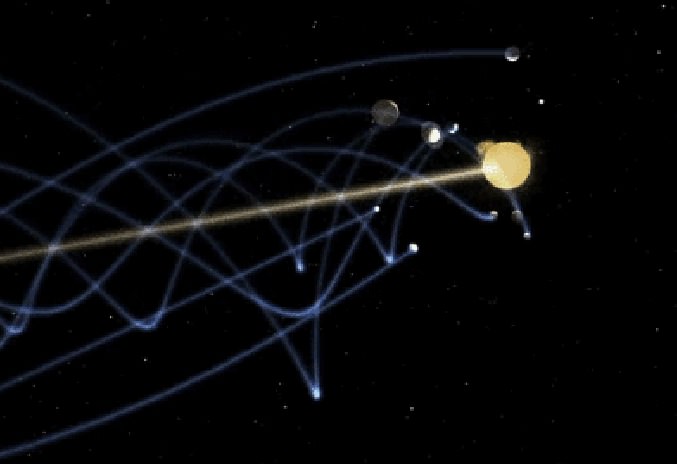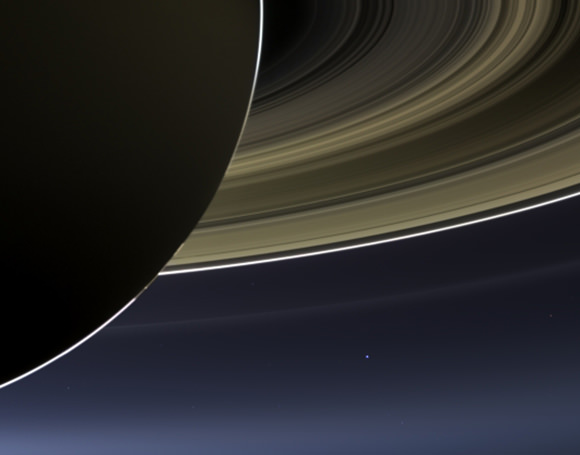Just take a look at the surface of the Moon and you can see it experienced a savage beating in the past. Turns out, the whole Solar System is a cosmic shooting gallery, with stuff crashing into other stuff. It sure sounds violent, but then, we wouldn’t be here without it.
Continue reading “Astronomy Cast Ep. 333: When Worlds Collide”
Why Is the Solar System Flat?
It’s no mystery that the planets, moons, asteroids, etc. in the Solar System are arranged in a more-or-less flat, plate-like alignment in their orbits around the Sun.* But why is that? In a three-dimensional Universe, why should anything have a particular alignment at all? In yet another entertaining video from the folks at MinutePhysics, we see the reason behind this seemingly coincidental feature of our Solar System — and, for that matter, pretty much all planetary systems that have so far been discovered (not to mention planetary ring systems, accretion disks, many galaxies… well, you get the idea.) Check it out above.
Video by MinutePhysics. Created by Henry Reich
Continue reading “Why Is the Solar System Flat?”
Wake Up, Rosetta!

It’s being called “the most important alarm clock in the Solar System” — this Monday, January 20, at 10:00 GMT (which is 5:00 a.m. for U.S. East Coasters like me) the wake-up call will ring on ESA’s Rosetta spacecraft, bringing it out of hibernation after over two and a half years in preparation of its upcoming and highly-anticipated rendezvous with a comet.
The wake-up will incite the warming of Rosetta’s star trackers, which allow it to determine its orientation in space. Six hours later its thrusters will fire to stop its slow rotation and ensure that its solar arrays are receiving the right amount of sunlight. Using its thawed-out star trackers Rosetta will aim its transmitter towards Earth and, from 500 million miles (807 million km) away, will send a thumbs-up signal that everything is OK and it’s time to get back to work.
From that distance the transmission will take 45 minutes to reach us. Rosetta’s first signal is expected between 17:30 – 18:30 GMT (12:30 – 1:30 p.m. ET). Once we’re assured all is well, Rosetta has a very exciting year ahead!
After nearly a decade of soaring through the inner solar system, flying past Mars and Earth several times and even briefly visiting a couple of asteroids (2867 Steins on September 5, 2008 and 21 Lutetia on July 10, 2010) Rosetta is finally entering the home stretch of its mission to orbit the 4-km-wide comet 67P/Churyumov-Gerasimenko.
Once Rosetta enters orbit around the comet — the first time a spacecraft has ever done so — it will map its surface and, three months later in November, deploy the 220-lb (100-kg) Philae lander that will intimately investigate the surface of the nucleus using a suite of advanced science instruments. (Watch a video here of how all this will happen… using Legos!)
Read more: Spider-Like Spacecraft Aims To Touch A Comet Next Year After Rosetta Reactivates
With Philae firmly attached to the comet, Rosetta will follow it around the Sun as it makes its closest pass in August 2015 and then heads back out towards the orbit of Jupiter. Rosetta will provide the most detailed observations ever of a comet’s composition and dramatic evolution as it encounters the heat and energy of our home star.
Of course, before all this can happen Rosetta first has to… WAKE UP! It entered hibernation in July 2011 and has remained silent in a slow spin ever since, with only its computer and some heaters kept running. Waking up from a 31-month nap can’t be easy, so ESA is inviting people around the world to help Wake Up Rosetta (and possibly even win a trip to Germany for the landing in November) by sharing their short movies of how best to awaken a sleeping spacecraft and sharing them to the contest page on Facebook or to Twitter, Vine, or Instagram with the #WakeUpRosetta hashtag.
See more about the contest below:
Video submissions to the Wake Up Rosetta video contest will be accepted until 17:30 GMT on Monday so if you haven’t already, get your cameras out and your imaginations going… this spacecraft isn’t going to wake itself! (Well, actually it kinda is but you can still show off your creativity!)
And even if you don’t send in a video, you can watch the live feed of Monday’s events from ESA starting at 09:15 GMT (4:15 a.m. ET) here and here. (Also follow @ESA_Rosetta on Twitter — currently it’s “still sleeping.”)
Want to find out where Rosetta is right now? Check out this cool interactive map from Daniel Scuka, Senior Editor of Spacecraft Operations at ESOC.
Rosetta launched on March 2, 2004 by an Ariane-5 G+ from Europe’s spaceport in Kourou, French Guiana. Read more on the mission page and the Rosetta blog here.
___________
UPDATE Jan. 20: Rosetta has awoken! This afternoon at 18:18 UTC, after 48 minutes of increasingly tense anticipation, a signal from the spacecraft was received by both NASA’s Deep Space Network in Goldstone, CA and the ground station in Canberra, Australia. Rosetta is up and running and so far seems to be in good condition — Go Rosetta and Philae! Read the full story here.
A Distant View of Janus, One of Saturn’s ‘Dancing Moons’
One of 62 moons discovered thus far orbiting giant Saturn, Janus is a 111-mile (179-km) -wide pockmarked potato composed of rock and ice rubble. The image above shows Janus as seen with Cassini’s narrow-angle camera on September 10, 2013, from a distance of 621,000 miles (1 million km), floating against the blackness of space.
Despite its apparent isolation in the image above, though, Janus isn’t alone. It shares its orbit around Saturn with its slightly smaller sister moon Epimetheus, and they regularly catch up to each other — and even switch places.
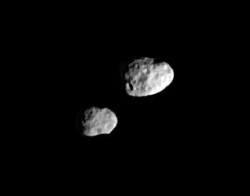
Janus and Epimetheus travel in nearly the same track, about 94,100 miles (151,500 km) out from Saturn. They occasionally pass each other, their gravity causing them to switch speeds and positions as they do; Janus goes faster and higher one time, slower and lower the next – but the two never come within more than about 6,200 miles of each other.
The two moons switch positions roughly every four years.
This scenario is referred to in astrophysics as a 1:1 resonance. Astronomers were initially confused when the moons were discovered in 1966 as it wasn’t known at the time that there were actually two separate moons in a single orbit. (This wasn’t confirmed until Voyager 1’s visit to Saturn in 1980.) It’s been suggested that Janus and Epimetheus will eventually come to orbit a single Lagrangian point around Saturn instead of trading places… in about another 20 million years.
The view above looks toward the Saturn-facing side of Janus. Covered in both dark and light colored material, Janus’ surface is thought to be coated with a layer of fine dust that slides down its steeper slopes, revealing the brighter ice beneath.
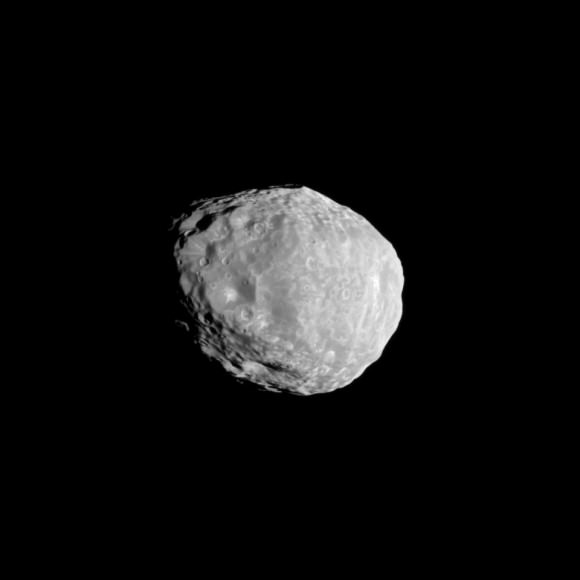
Want to see more images of Janus? Click here.
Source: Cassini Solstice Mission release
Is the Solar System Really a Vortex?
The short answer? No. Not in the way that a popular animated gif insinuates, at least.
If you’re even a casual space fan you may have seen a viral gif animation showing our solar system traveling through space, the motions of the planets tracing corkscrew “vortex” paths around a line-driving Sun. While it’s definitely intriguing to watch (in that mesmerizingly-repetitive gif fashion) and rendered with a talented flair for design, there are two fundamental problems with it. One: it’s not entirely correct, scientifically, and two: its creator’s intention is to illustrate a decidedly un-scientific point of view about the Solar System and the Universe as a whole.
For the long answer, I now offer up the stage to astrophysicist Rhys Taylor, who recently posted an in-depth article describing why the planets do yet move… just not like that.
Reposted with permission from Rhys Taylor’s blog, Physicists (Formerly) of the Caribbean:
There’s this annoying space GIF roaming the internet causing trouble. Perhaps you’ve seen it. No ? Well, here it is.

What it purports to show is the motion of the Solar System through space. But the accuracy of this has been utterly derided as an affront to scientific dignity. Which is a shame, because the video version is really quite nicely done, with good camera movement and a catchy soundtrack. The principle antagonist is notorious “Bad Astronomer” Phil Plait, who wrote a convincing and virulent attack on the video. I decided to investigate for myself.
Like many people, I was at first glance really quite impressed with the video, and didn’t have any major objections to it. Obviously the orbits and size of the planets are not to scale (and I think their orbital speeds have be altered too), but that’s just to make them visible. Fair enough. But then I read Phil Plait’s analysis, and it seems that things are much, much worse than that. Says Plait :
“Sadhu shows the Sun leading the planets, ahead of them as it goes around the galaxy… This is not just misleading, it’s completely wrong.”
He clarifies :
“Sometimes the planets really are ahead of the Sun as we orbit in the Milky Way, and sometimes trail behind it (depending on where they are in their orbit around the Sun).” [my italics]
The orbits of the major planets of the solar system all lie in a narrow plane (like being in economy class! hahaha… sorry), which is tilted at about 60 degrees to the disc of stars that forms the Milky Way. Like this:
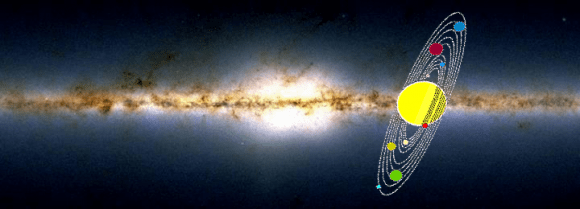
We’ll return to the tilt in a moment. But first, if the Sun was really leading the planets, then the thing is completely ludicrous (and this is quite a major part of Plait’s argument). Yet I’m not so sure the viral gif does show the Sun leading the planets. Having read through the author’s website, I can’t find any evidence that he suggests this. In fact, some of other videos on his website clearly show that this isn’t the case:
It seems to me that the appearance of the Sun leading the planets in the gif is just the result of a projection effect – i.e. that things can look different from different angles. On the other hand, Plait read the source material for Sadhu’s model, so maybe there’s something in there that’s more explicit. I’ve glanced at it, but couldn’t find anything stating this precisely. Actually I couldn’t find a whole lot that was even vaguely coherent, but we’ll return to this later. For now, just keep in mind that Sadhu is using an alternative model, even though that may not always be evident.
What the gif definitely does not show is the fact that the orbits of the planets are tilted at about 60 degrees to the direction of the Sun’s motion. Says Plait :
“In the helical model, he shows the planets as orbiting around the Sun perpendicular to the motion of the Sun around the galaxy; “face-on”, if you like.This is wrong. Because the orbits of the planets are tipped by 60°, not 90°, they can sometimes be ahead and sometimes behind the Sun. That right there, and all by itself, shows this helical depiction is incorrect.”
There can be no mistaking that Sadhu’s video shows the orbits with the wrong tilt. But is that so critical? Well actually no, not really. Fact is that if you include the tilt, you still see the planets making a “spiral” pattern (technically it’s a helix) as they move through space. The overall appearance just isn’t that massively different compared to a 90-degree tilt.
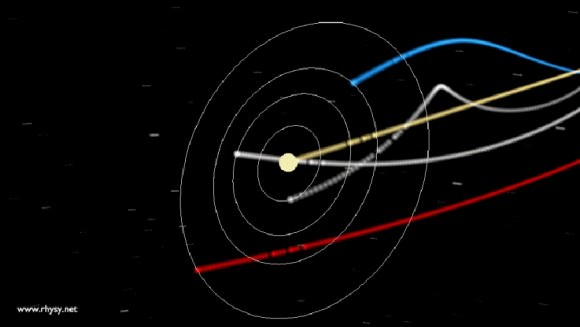
So what’s the big deal? What does the author claim in this internet sensation that’s so outrageous? Well, not much. That particular video/gif are actually fairly inoffensive, to my mind. The most basic notion that the planets trace helical paths through space is perfectly correct. What honestly surprises me is that this is so incredibly popular on the internet. If you weren’t aware that the Sun orbits the center of the galaxy — which, since the planets orbit it, necessitates that they trace out helical paths — then the education system has seriously failed. But do not despair! This can be remedied very, very easily.
But we’re not done yet. There’s a sting in the tail, and it’s a big one. The gif doesn’t show it, but the video version ends with the worrying remarks that:
“Rotational motion and vortex motion are completely different things.”*
“Life spirals.” [Picture of leaves]
“Life is vortex, not just rotation.” [Picture of developing ferns, then a flower, the Milky Way, the DNA double helix, etc.]
“The Solar System is part of life. Think about this while racing through space.”
*Yes, they are. Plait notes: “They’re different in more than just name; they’re actually very different physical motions with different properties—you can get helical motion without the particles in it interacting, like in the solar system, but in a vortex the particles interact through drag and friction.” Basically, claiming that the Solar System is a vortex is simply wrong. Sadhu appears not to have checked the word “vortex” in a dictionary.
I could forgive even these rather hippyish sentiments, if they were no more than that. Alas, they’re symptomatic of a much larger problem. Plait’s merciless attack is full of sound and fury, but it’s also signifying something. Reading more of the author’s website, it turns out he is actively promoting quackery. It’s on a par with the excellent Space Mirror Mystery* (the idea that everything further away than about 150 million km is just a reflection in a giant mirror), but less funny.
*I was delighted to find that this website is back online. Seriously, read it. It’s epic.
From Sadhu’s website:
“In this diagram it seems the Solar System travel to the left. When the Earth is also traveling[sic] to the left (for half a year) it must go faster than the Sun. Then in the second half of the year, it travels in a ‘relative opposite direction’ so it must go slower than the Sun. Then, after completing one orbit, it must increase speed to overtake the Sun in half a year. And this would go for all the planets. Just like any point you draw on a frisbee will not have a constant speed, neither will any planet.”
Apparently he thinks this is a problem. Worryingly, it suggests that he didn’t show the 60-degree orbital tilt not for mere simplicity, but because he doesn’t believe it’s possible. Which — if true — is utter madness, pure and simple. There’s absolutely no reason the planetary speeds have to be constant as they move around the galaxy — the massive gravitational pull of the Sun is keeping them firmly in its orbit, regardless of how those orbits are inclined.
“Secondly, most planets are visible throughout the entire year. In a ‘flat’ model, every single planet would hide behind the Sun at least once a year. They don’t. Now the heliocentric model isn’t entirely flat, but mostly.”
Fine. The heliocentric model isn’t flat, which perfectly explains why planets aren’t eclipsed by the Sun once per year. What need to state this ? Is he really saying that this is a problem in a heliocentric model…? SERIOUSLY?
“Fact of the matter is that if the helical model is correct and our Solar System is a traveling[sic] vortex, it will change how we feel about our journey. For me personally the heliocentric model feels like a useless marry[sic]-go-round: after one year we are back to square one. The helical model feels much more like progress, growth, a journey through space in which we never ever come back to our starting point. We are NOT in a big marry[sic]-go-round. We are on a journey.”
Planets trace a helical path in space because our Solar System is orbiting the center of the galaxy. Big bloody deal. It’s that simple. You don’t need a wacky alternative model of the Solar System for this – it’s happening anyway! As for going on a journey though – well no, not really. Every other star is also orbiting the center of the galaxy, so no, we’re not actually getting anywhere relative to other star systems.
Then there are some pointless ravings about the Mayan calendar.
He also links the following video. Skip to about 2 minutes in:
This has the bizarre quote that :
“The planets do not come back on to their [own] path[s]. They don’t. If they did, we most likely would have the same set of information over and over and over… like a broken record. And we’d probably get bored. It would be like Groundhog Year.”
Then he links a video claiming that the Fibonacci sequence is the fingerprint of God.
None of which changes the fact that his first video/gif has only minor inaccuracies, but at this point I can’t help feeling that this was more by luck than judgement.
Then there’s his second video. This one is more objectively just plain wrong. He shows the Sun tracing out a corkscrew pattern as it orbits the galaxy, which makes no sense. The Sun simply goes around the center of the galaxy (and up and down a little bit) — nothing else. It’s not orbiting anything else at the same time. For it to trace a helix is just nonsense. He seems to have an almost unique case of helix madness.
What of the source material — the alternative model Sadhu uses? Garbage. Utter garbage. I find it difficult to read more than a sentence or two, because it’s verging on incomprehensible. As in almost at the level of TimeCube.
“Three types of time may be recognized:
– An absolute time that is universal and has neither a known starting point nor an end point; not even limited to a measurable parameter.
– For living organisms there is a time for birth and a moment for death. The interval is the life span. This time may be measured with parameters like seconds, minutes, days and so on. Mechanical devices may measure fractions and to some extant reliable. In every case some kind of energy source or gear system is involved.
-–When one is engaged with some work involvement in another activity may be impossible or result to be unnatural. In such cases personal values decide what course to take up and say “no time” to the other work, however important that may be. This time is highly subjective.”
Later:
“The constellations at the background are sufficient evidence to deny the heliocentric orbits for planets. The Sun at 500 light seconds distance, when visible within a cone of 30° maintaining a background of one constellation, say for example Aries, (Hamel at 68ly) the SOLSTICES and EQUINOXES through Zodiac Earth maintains in the opposite constellation at midnight, namely Libra. After six months to maintain heliocentric orbit, the mid day of today should become midnight and the midnight should become midday. This has not taken place!“
Well of course it hasn’t — it’s complete gibberish ! Plait may well be right that somewhere in this mess is a model wherein the Sun leads the planets, but I don’t have the time or sheer mental fortitude to read the whole thing. I will note, though, that there’s a paragraph where the author rubbishes the conventional explanation for the ozone hole — and God help us all if that goes viral. That, not petty disputes about whether the orbits of planets are tilted by 60 or 90 degrees, is why such quackery deserves to be shot down without mercy.
“My feeling is that if your take-home message was only that the Solar System moves through space, and the planets trace out pretty spirally paths, then all is well and no harm done. But if it’s leading you to question the heliocentric model, then we’re all buggered.”
–Rhys Taylor, astrophysicist
In conclusion then, the first video and gif of the Solar System as a “vortex” are not really all that bad. Unfortunately, the inaccuracies are not due to some minor over-simplifications, but are symptoms of a some very deep-seated misunderstandings. My feeling is that if your take-home message was only that the Solar System moves through space, and the planets trace out pretty spirally paths, then all is well and no harm done. But if it’s leading you to question the heliocentric model, then we’re all buggered.
___________________
Thanks to Rhys Taylor for the guest post of his entertaining and informative article — at the very least, you got to watch “The Galaxy Song” again! Read more from Rhys (and check out some really nice infographics too) on his blog here.
Can Stars Collide?
Imagine a really bad day. Perhaps you’re imagining a day where the Sun crashes into another star, destroying most of the Solar System.
No? Well then, even in your imagination things aren’t so bad… It’s all just matter of perspective.
Fortunately for us, we live in out the boring suburbs of the Milky Way. Out here, distances between stars are so vast that collisions are incredibly rare. There are places in the Milky Way where stars are crowded more densely, like globular clusters, and we get to see the aftermath of these collisions. These clusters are ancient spherical structures that can contain hundreds of thousands of stars, all of which formed together, shortly after the Big Bang.
Within one of these clusters, stars average about a light year apart, and at their core, they can get as close to one another as the radius of our Solar System. With all these stars buzzing around for billions of years, you can imagine they’ve gotten up to some serious mischief.
Within globular clusters there are these mysterious blue straggler stars. They’re large hot stars, and if they had formed with the rest of the cluster, they would have detonated as supernovae billions of years ago. So scientists figure that they must have formed recently.
How? Astronomers think they’re the result of a stellar collision. Perhaps a binary pair of stars merged, or maybe two stars smashed into one another.
Professor Mark Morris of the University of California at Los Angeles in the Department of Physics and Astronomy helps to explain this idea.
“When you see two stars colliding with each other, it depends on how fast they’re moving. If they’re moving at speeds like we see at the center of our galaxy, then the collision is extremely violent. If it’s a head-on collision, the stars get completely splashed to the far corners of the galaxy. If they’re merging at slower velocities than we see at our neck of the woods in our galaxy, then stars are more happy to merge with us and coalesce into one single, more massive object.”
There’s another place in the Milky Way where you’ve got a dense collection of stars, racing around at breakneck speeds… near the supermassive black hole at the center of the galaxy.
This monster black hole contains the mass of 4 million times the Sun, and dominates the region around the center of the Milky Way.
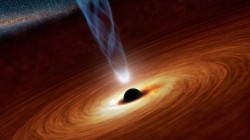
“The core of the Milky Way is one of those places where you find the extremes of nature. The density of stars there is higher than anywhere else in the galaxy,”Professor Morris continues. “Overall, in the center of our galaxy on scales of hundreds of light years, there is much more gas present than anywhere else in the galaxy. The magnetic field is stronger there than anywhere else in the galaxy, and it has it’s own geometry there. So it’s an unusual place, an energetic place, a violent place, because everything else is moving so much faster there than you see elsewhere.”
“We study the stars in the immediate vicinity of the black hole, and we find that there’s not as many stars as one might have expected, and one of the explanations for that is that stars collide with each other and either eliminate one another or merge, and two stars become one, and both of those processes are probably occurring.”
Stars whip around it, like comets dart around our Sun, and interactions are commonplace.
There’s another scenario that can crash stars together.
The Milky Way mostly has multiple star systems. Several stars can be orbiting a common center of gravity. Many are great distances, but some can have orbits tighter than the planets around our Sun.
When one star reaches the end of its life, expanding into a red giant, It can consume its binary partner. The consumed star then strips away 90% of the mass of the red giant, leaving behind a rapidly pulsating remnant.
What about when galaxies collide? That sounds like a recipe for mayhem.
Surprisingly, not so much.
“That’s actually a very interesting question, because if you imagine two galaxies colliding, you’d imagine that to be an exceptionally violent event,’ Professor Morris explains. “But in fact, the stars in those two galaxies are relatively unaffected. The number of stars that will collide when two galaxies collide is possibly counted on the fingers of one or two hands. Stars are so few and far between that they just aren’t going to meet each other with any significance in a field like that.”
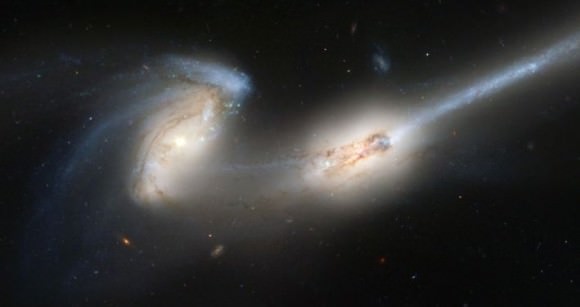
“What you see when you see two galaxies collide, however, on the large scale, is that the tidal forces of the two galaxies will rip each of the galaxies apart in terms of what it will look like. Streams of stars will be strewn out in various directions depending on the precise history of the interaction between the two galaxies. And so, eventually over time, the galaxies will merge, the whole configuration of stars will settle down into something that looks unlike either of the two initially colliding galaxies. Perhaps something more spheroidal or spherical, and it might look more like an elliptical galaxy than the spiral galaxy that these two galaxies now are.”
Currently, we’re on a collision course with the Andromeda Galaxy, and it’s expected we’ll smash into it in about 4 billion years. The gas and dust will collide and pile up, igniting an era of furious star formation. But the stars themselves? They’ll barely notice. The stars in the two galaxies will just streak past each other, like a swarm of angry bees.
Phew.
So, good news! When you’re imagining a worse day, you won’t have to worry about our Sun colliding with another star. We’re going to be safe and sound for billions of years. But if you live in a globular cluster or near the center of the galaxy, you might want to check out some property here in the burbs.
Thanks to Professor Mark Morris at UCLA – visit their Physics and Astronomy program homepage here.
Hubble Discovers Water Plumes Erupting from Europa
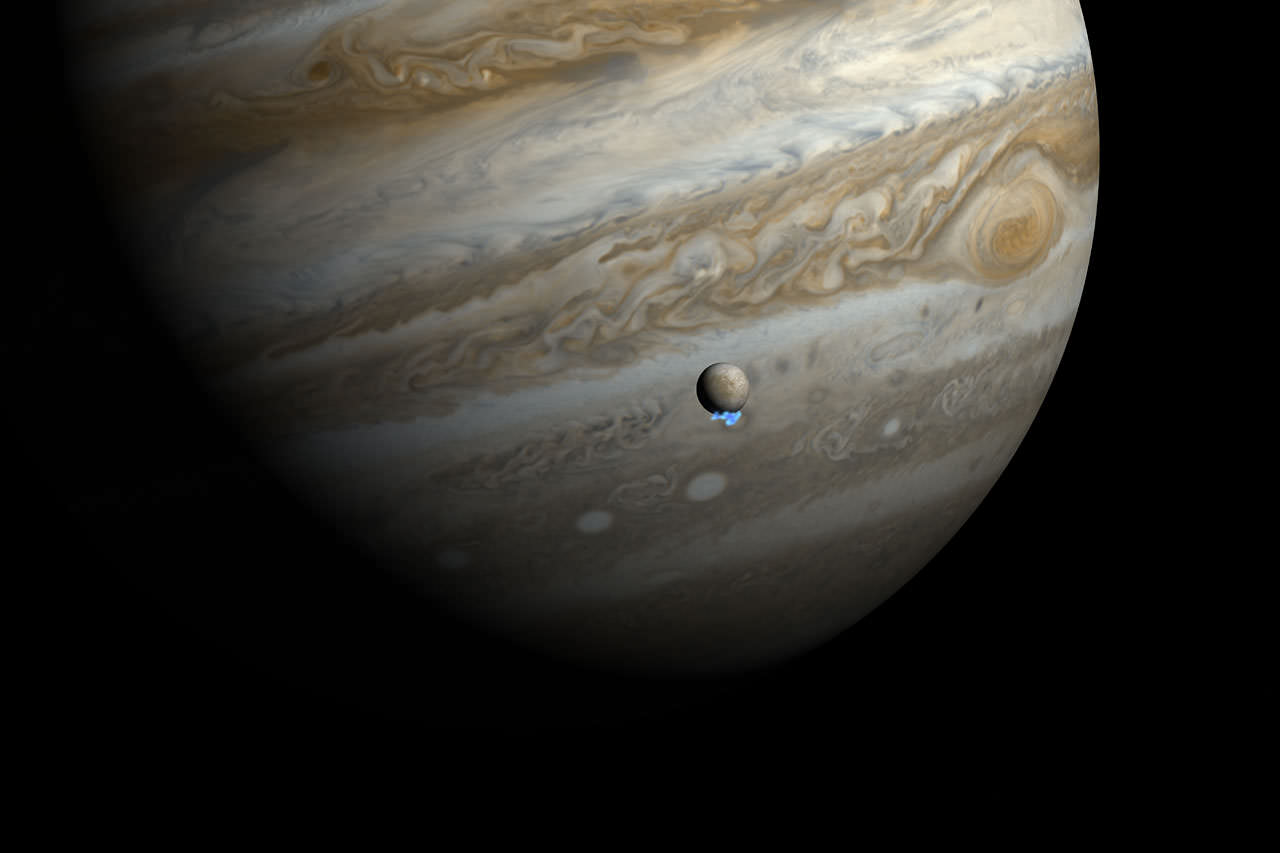
It’s been known since 2005 that Saturn’s 300-mile-wide moon Enceladus has geysers spewing ice and dust out into orbit from deep troughs that rake across its south pole. Now, thanks to the Hubble Space Telescope (after 23 years still going strong) we know of another moon with similar jets: Europa, the ever-enigmatic ice-shelled moon of Jupiter. This makes two places in our Solar System where subsurface oceans could be getting sprayed directly into space — and within easy reach of any passing spacecraft.
(Psst, NASA… hint hint.)
The findings were announced today during the meeting of the American Geophysical Union in San Francisco.
“The discovery that water vapor is ejected near the south pole strengthens Europa’s position as the top candidate for potential habitability,” said lead author Lorenz Roth of the Southwest Research Institute (SwRI) in San Antonio, Texas. “However, we do not know yet if these plumes are connected to subsurface liquid water or not.”
The 125-mile (200-km) -high plumes were discovered with Hubble observations made in December 2012. Hubble’s Space Telescope Imaging Spectrograph (STIS) detected faint ultraviolet light from an aurora at the Europa’s south pole. Europa’s aurora is created as it plows through Jupiter’s intense magnetic field, which causes particles to reach such high speeds that they can split the water molecules in the plume when they hit them. The resulting oxygen and hydrogen ions revealed themselves to Hubble with their specific colors.
Unlike the jets on Enceladus, which contain ice and dust particles, only water has so far been identified in Europa’s plumes. (Source)
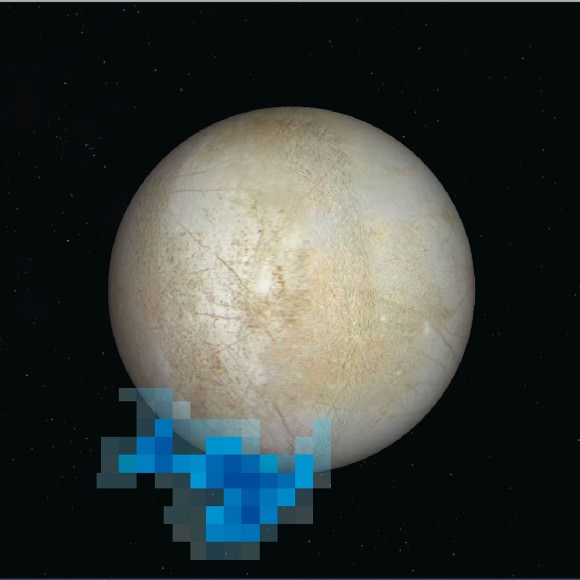
The team suspects that the source of the water is Europa’s long-hypothesized subsurface ocean, which could contain even more water than is found across the entire surface of our planet.
Read more: Europa’s Hidden Great Lakes May Harbor Life
“If those plumes are connected with the subsurface water ocean we are confident exists under Europa’s crust, then this means that future investigations can directly investigate the chemical makeup of Europa’s potentially habitable environment without drilling through layers of ice,” Roth said. “And that is tremendously exciting.”
One other possible source of the water vapor could be surface ice, heated through friction.
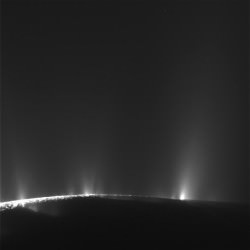
In addition the Hubble team found that the intensity of Europa’s plumes, like those of Enceladus, varies with the moon’s orbital position around Jupiter. Active jets have been seen only when Europa is farthest from Jupiter. But the researchers could not detect any sign of venting when Europa is closer.
One explanation for the variability is Europa undergoes more tidal flexing as gravitational forces push and pull on the moon, opening vents at larger distances from Jupiter. The vents get narrowed or even seal off entirely when the moon is closest to Jupiter.
Still, the observation of these plumes — as well as their varying intensity — only serves to further support the existence of Europa’s ocean.
“The apparent plume variability supports a key prediction that Europa should tidally flex by a significant amount if it has a subsurface ocean,” said Kurt Retherford, also of SwRI.
(Science buzzkill alert: although exciting, further observations will be needed to confirm these findings. “This is a 4 sigma detection, so a small uncertainly that the signal is just noise in the instruments,” noted Roth.)
“If confirmed, this new observation once again shows the power of the Hubble Space Telescope to explore and opens a new chapter in our search for potentially habitable environments in our solar system.”
– John Grunsfeld, NASA’s Associate Administrator for Science
Read more: Hydrogen Peroxide Could Feed Life on Europa
So. Who’s up for a mission to Europa now? (And unfortunately in this case, Juno doesn’t count.)
“Juno is a spinning spacecraft that will fly close to Jupiter, and won’t be studying Europa,” Kurt Retherford told Universe Today. “The team is looking hard how we can optimize, maybe looking for gases coming off Europa and look at how the plasma interacts with environment, so we really need a dedicated Europa mission.”
We couldn’t agree more.
The findings were published in the Dec. 12 online issue of Science Express.
Sources: Hubble news releases (US and ESA)
Image credits:
Graphic Credit: NASA, ESA, and L. Roth (Southwest Research Institute and University of Cologne, Germany)
Science Credit: NASA, ESA, L. Roth (Southwest Research Institute and University of Cologne, Germany), J. Saur (University of Cologne, Germany), K. Retherford (Southwest Research Institute), D. Strobel and P. Feldman (Johns Hopkins University), M. McGrath (Marshall Space Flight Center), and F. Nimmo (University of California, Santa Cruz)
Is Everything in the Universe Expanding?
The Universe is expanding. Distant galaxies are moving away from us in all directions. It’s natural to wonder, is everything expanding? Is the Milky Way expanding? What about the Solar System, or even objects here on Earth. Are atoms expanding?
Nope. The only thing expanding is space itself. Imagine the Universe as loaf of raisin bread rising in the oven. As the bread bakes, it’s stretching in all directions – that’s space. But the raisins aren’t growing, they’re just getting carried away from each other as there’s more bread expanding between them.
Space is expanding from the Big Bang and the acceleration of dark energy. But the objects embedded in space, like planets, stars, and galaxies stay exactly the same size. As space expands, it carries galaxies away from each other. From our perspective, we see galaxies moving away in every direction. The further galaxies are, the faster they’re moving.
There are a few exceptions. The Andromeda Galaxy is actually moving towards the Milky Way, and will collide with us in about 4 billion years.In this case, the pull of gravity between the Milky Way and Andromeda is so strong that it overcomes the expansion of the Universe on a local level.
Within the Milky Way, gravity holds the stars together, and same with the Solar System. The nuclear force holding atoms together is stronger than this expansion at a local scale. Is this the way it will always be? Maybe. Maybe not.
A few decades ago, astronomers thought that the Universe was expanding because of momentum left over from the Big Bang. But with the discovery of dark energy in 1998, astronomers realized there was a new possibility for the future of the Universe. Perhaps this accelerating dark energy might be increasing over time.
In billions years from now, the expansive force might overcome the gravity that holds galaxies together. Eventually it would become so strong that star systems, planets and eventually matter itself could get torn apart.This is a future for the Universe known as the Big Rip. And if it’s true, then the space between stars, planets and even atoms will expand in the far future.
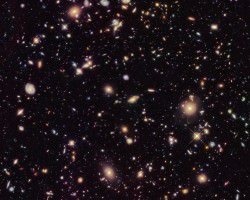
Is this going to happen? Astronomers don’t know. Their best observations so far can’t rule it out, or confirm it. And so, future observations and space missions will try to calculate the rate of dark energy’s expansion.
So no, matter on a local level isn’t expanding. The spaces between planets and stars isn’t growing. Only the distances between galaxies which aren’t gravitationally bound to each other is increasing. Because space itself is expanding.
Where Should We Look for Life in the Solar System?
Emily Lakdawalla is the senior editor and planetary evangelist for the Planetary Society. She’s also one of the most knowledgeable people I know about everything that’s going on in the Solar System. From Curiosity’s exploration of Mars to the search for life in the icy outer reaches of the Solar System, Emily can give you the inside scoop.
In this short interview, Emily describes where she thinks we should be looking for life in the Solar System.
Follow Emily’s blog at the Planetary Society here.
Follow her on Twitter at @elakdawalla
And Circle her on Google+
Continue reading “Where Should We Look for Life in the Solar System?”
The Day the Earth Smiled: Saturn Shines in this Amazing Image from the Cassini Team
This summer, for the first time ever, the world was informed that its picture was going to be taken from nearly a billion miles away as the Cassini spacecraft captured images of Saturn in eclipse on July 19. On that day we were asked to take a moment and smile and wave at Saturn, from wherever we were, because the faint light from our planet would be captured by Cassini’s camera, shielded by Saturn from the harsh glare of the Sun.
A few preliminary images were released just a few days later showing the “pale blue dot” of Earth nestled within the glowing bands of Saturn’s rings. It was an amazing perspective of our planet, and we were promised that the full mosaic of Cassini images was being worked on and would be revealed in the fall.
Well, it’s fall, and here it is:
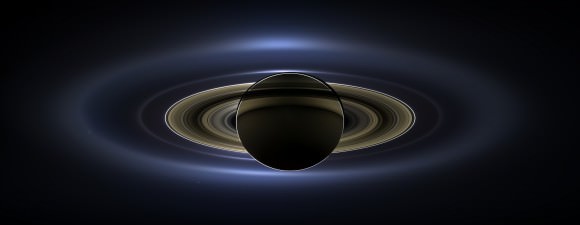
Simply beautiful!
Cassini Imaging Team leader Carolyn Porco wrote on her Facebook page:
“After much work, the mosaic that marks that moment the inhabitants of Earth looked up and smiled at the sheer joy of being alive is finally here. In its combination of beauty and meaning, it is perhaps the most unusual image ever taken in the history of the space program.”
Download a full-size version here.
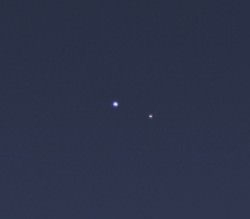
In this panorama of the Saturnian system, a view spanning 404,880 miles (651,591 km), we see the planet silhouetted against the light from the Sun. It’s a unique perspective that highlights the icy, reflective particles that make up its majestic rings and also allows our own planet to be seen, over 900 million miles distant. And it’s not just Earth that was captured, but the Moon, Venus, and Mars were caught in the shot too.
Read more: Could Cassini See You on the Day the Earth Smiled?
According to the description on the CICLOPS page, “Earth’s twin, Venus, appears as a bright white dot in the upper left quadrant of the mosaic… between the G and E rings. Mars also appears as a faint red dot embedded in the outer edge of the E ring, above and to the left of Venus.”
This was no simple point-and-click. Over 320 images were captured by Cassini on July 19 over a period of four hours, and this mosaic was assembled from 141 of those images. Because the spacecraft, Saturn, and its moons were all in constant motion during that time, affecting not only positions but also levels of illumination, imaging specialists had to adjust for that to create the single image you see above. So while all elements may not be precisely where they were at the same moment in time, the final result is no less stunning.
“This version was processed for balance and beauty,” it says in the description. (And I’ve no argument with that.)
See below for an annotated version showing the position of all visible objects, and read the full article on the CICLOPS page for an in-depth description of this gorgeous and historic image.
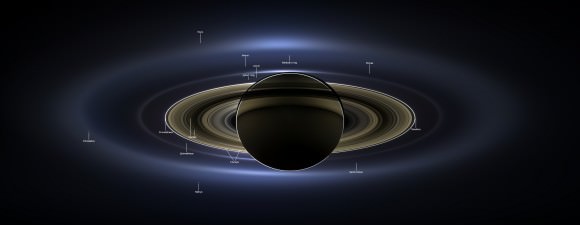
“I hope long into the future, when people look again at this image, they will recall the moment when, as crazy as it might have seemed, they were there, they were aware, and they smiled.”
–Carolyn Porco, Cassini Imaging Team Leader
Also, check out another version of this image from NASA made up of submitted photos from people waving at Saturn from all over the world. (Full NASA press release here.)
All images credit NASA/JPL-Caltech/Space Science Institute
UPDATE 11/13: CICLOPS Director Carolyn Porco describes how this image was acquired and assembled in this interview video from the World Science Festival:

